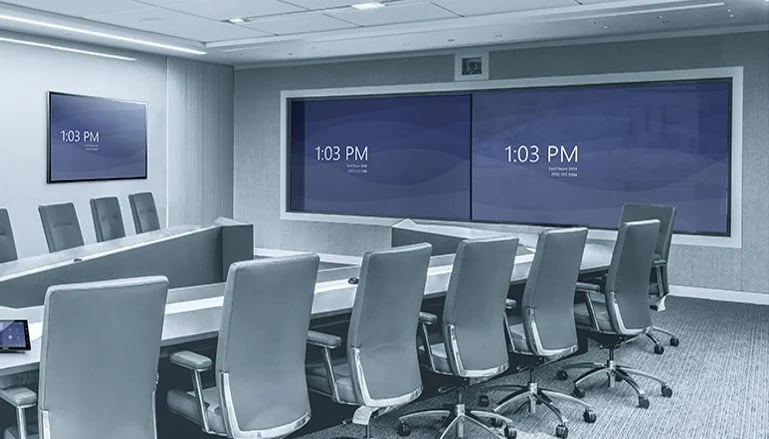A Meeting Experience You Know
For those who have been using Microsoft Teams for video, especially during a prolonged period at home, you have become very familiar with how the platform looks and works. You can intuitively manage your meetings and Microsoft integrations and know what to expect every time.
When you are back in the office and have conference rooms that run on Microsoft Teams, many people want the touch panel to reflect this user experience you are comfortable with. When your collaboration rooms reflect the exact look and feel of your user experience with Microsoft, this is called a “Native Teams Experience”.
What does a native Teams experience look like practically for the meeting rooms in your organization? If you have Microsoft Teams in your rooms or are looking to implement Teams soon, there are some things to keep in mind in the process. Here are five things to consider for your organization’s native Teams experience.
1. A Native Teams experience is just for Teams
Microsoft Teams has become one of the most popular video conferencing platforms in the world, but a native Teams experience only works for, well, Teams. This means there would be issues if you wanted to host or join a Zoom meeting from your conference room. While there are some workarounds, mostly having to do with more complicated updates to your Team infrastructure and account configuration, you would want to keep in mind that your intuitive touch panel will really only be helpful for your Teams experience out of the box.
2. Interface elements are what Microsoft wants and ONLY what Microsoft wants
The native experience is locked so that the buttons on the user interface are the elements that Microsoft has selected and there isn’t room for customization. However, these features are the essentials for running a successful video conference, such as Present, Share, Dial, Volume, Meeting Join, and so on.
3. Awesome features will still have limitations
While the native Teams experience is seamless, effective, and easy to use, there are still some shortcomings. As said previously, there isn’t native ability to join Zoom or Webex meetings from the room. The audio settings are also limited, as well as some of the content sharing features. And using the dial pad requires a Microsoft calling plan or custom integration to content your non-Teams SIP phone system. These are some of the limitations that you’d run into, but with the help of an integrator, there are possible workarounds.
4. There will be some challenges with native Teams in legacy conference rooms
When you want to incorporate Teams into your existing rooms, it is understandable to want to use the quality technology you currently have. However, you will face some challenges in this process and may not be able to reuse all the devices.
Picture if your room has a Poly or Cisco video conferencing unit. If this is the case, implementing native Teams in these legacy systems would cause you to think about disposing of the legacy video conferencing units versus the cost of a custom integration to gain interoperability with the legacy conferencing systems.
5. Standardization is ideal, but will need some workaround to get set up across your rooms
Especially if you have multiple conference rooms across campuses or buildings, you want a standard experience in all collaboration rooms. The native Teams experience can bring up some hurdles, but with certain workarounds you can provide a seamless standardization across rooms.
For example, you may elect to initiate Teams from a PC versus native Teams. What does this mean? It simply means that in certain more complicated room systems you might select a Teams button on a touch panel which would then use the PC in the physical meeting room. Next, after selecting this local room PC, you would log in with a keyboard and mouse, and initiate Teams. This potential workaround is desirable at times, particularly in larger custom rooms with multiple displays, more complex audio systems, and/or the ability to have other UC systems available, such as an audio conferencing system.
Rely on a Microsoft Teams Partner
Whether you are keeping your legacy equipment or rolling out new Microsoft Teams Rooms, it is helpful to bring on a Teams partner to handle the engineering, installation, and support. Profound Technologies is a Microsoft Partner with over 20 years of experience in the AV space. Not only can we help you set up your room, but we can help workaround some native Teams limitations to provide you with more options to standardize and customize your rooms.
To learn more about Microsoft Teams Rooms, hear directly from AV experts who have real life stories about implementing a native Teams experience across fleets of rooms! Listen to our webinar from March 18th to join Profound Technologies’ COO Kevin Busza and special guest Christopher Richardson, former Infrastructure Architect for Accenture Federal, as they discuss the features, limitations, and workarounds for native Teams rooms and provide helpful solutions to support your system long term.




